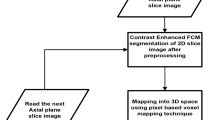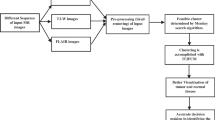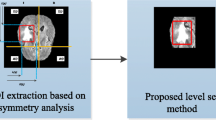Abstract
Manual segmentation of brain tumour is a time-consuming process and the result of segmentation varies from person to person. Also, automated tumour region detection has become very crucial for introducing robotics based treatment in the field of medical application. For a precise detection of the complete tumour region, a two phase technique is developed in this work. In the first phase, 2D Magnetic resonance (MR) image slices of axial plane are segmented by applying Fuzzy c-means (FCM) clustering algorithm. The decision about the presence or absence of tumour has been taken by calculating the Confidence function value for all the positively segmented pixels. Subsequently, in second phase, decision values corresponding to the 2D MR slices have been projected in the 3D plane. Evaluation of Confidence function helps to remove a number of false positive pixels from the FCM clustered image. The proposed method has been verified using BRATS 2013, BRATS 2015 and BRATS 2018 databases. Performance evaluation of complete tumour region with BRATS 2013 dataset produces sensitivity, dice similarity score, and specificity of 0.938, 0.9525 and 0.989 respectively. Similarly, sensitivity, dice similarity score, and specificity of value 0.938, 0.9525 and 0.989 has been obtained respectively in BRATS 2015 dataset verification. Performance evaluation with BRATS 2018 dataset produces average Dice score, sensitivity and specificity of 0.921, 0.940 and 0.980 respectively. Performance analysis of the system indicates that the complete tumour region can be detected with improved accuracy using the proposed two-phase method.







Similar content being viewed by others
References
Abdel-Maksoud E, Elmogy M, Al-Awadi R (2015) Brain tumor segmentation based on a hybrid clustering technique. Egypt Inform J 16(1):71–81
Ahmed HM, Youssef BAB, Elkorany AS et al (2019) Hybridized classification approach for magnetic resonance brain images using gray wolf optimizer and support vector machine. Multimed Tools Appl 78:27983–28002
Akbar AS, Fatichah C, Suciati N (2000) Simple MyUnet3D for BraTS segmentation. In: 2020 4th International Conference on Informatics and Computational Sciences (ICICoS), Semarang, 1–6 https://doi.org/10.1109/ICICoS51170.2020.9299072
Anitha V, Murugavalli S (2016) Brain tumour classification using two-tier classifier with adaptive segmentation technique. IET Comput Vision 10(1):9–17
Arulanandam S, Selvarasu S (2018) Adaptive weighted fuzzy region based optimization for brain MR image segmentation. Multimed Tools Appl 79(5):1–19
Aslam A, Khan E, Beg MM (2015) Improved edge detection algorithm for brain tumor segmentation. Procedia Comput Sci 58:430–437
Begum SS, Lakshmi DR (2020) Combining optimal wavelet statistical texture and recurrent neural network for tumour detection and classification over MRI. Multimed Tools Appl 79:14009–14030
Bharath HN, Sima DM, Sauwen N, Himmelreich U, De Lathauwer L, Van Huffel S (2016) Nonnegative canonical polyadic decomposition for tissue-type differentiation in gliomas. IEEE J Biomed Health Inform 21(4):1124–1132
Busa S, Vangala NS, Grandhe P, Balaji V (2019) Automatic brain tumor detection using fast Fuzzy C-means algorithm. In: Innovations in Computer Science and Engineering. Springer, Singapore, 249–254
Chahal PK, Pandey S, Goel S (2020) A survey on brain tumor detection techniques for MR images. Multimed Tools Appl. https://doi.org/10.1007/s11042-020-08898-3
Chilla GSV, Tan CH, Poh CL (2017) Deformable registration-based super-resolution for isotropic reconstruction of 4-D MRI volumes. IEEE J Biomed Health Inform 21(6):1617–1624
Debnath S, Talukdar FA (2019) Brain tumour segmentation using memory based learning method. Multimed Tools Appl 78(16):23689–23706
Debnath S, Talukdar FA, Islam M (2020) Combination of contrast enhanced fuzzy c-means (CEFCM) clustering and pixel based voxel mapping technique (PBVMT) for three dimensional brain tumour detection. J Ambient Intell Human Comput. https://doi.org/10.1007/s12652-020-02366-4
Demirhan A, Törü M, Güler İ (2014) Segmentation of tumor and edema along with healthy tissues of brain using wavelets and neural networks. IEEE J Biomed Health Inform 19(4):1451–1458
Havaei M, Davy A, Warde-Farley D, Biard A, Courville A, Bengio Y, Larochelle H (2017) Brain tumor segmentation with deep neural networks. Med Image Anal 35:18–31
Islam M, Laskar RH (2018) Robust image watermarking technique using support vector regression for blind geometric distortion correction in lifting wavelet transform and singular value decomposition domain. J Electron Imaging 27(5):053008
Kamnitsas K, Ledig C, Newcombe VF et al (2017) Efficient multi-scale 3D CNN with fully connected CRF for accurate brain lesion segmentation. Med Image Anal 36:61–78
Lin GC, Wang CM, Wang WJ, Sun SY (2010) Automated classification of multispectral MR images using unsupervised constrained energy minimization based on fuzzy logic. Magn Reson Imaging 28(5):721–738
Menze BH, Jakab A, Bauer S, Kalpathy-Cramer J, Farahani K, Kirby J, Lanczi L (2014) The multimodal brain tumor image segmentation benchmark (BRATS). IEEE Trans Med Imaging 34(10):1993–2024
Mudgal TK, Gupta A, Jain S, Gusain K (2017) Automated system for brain tumour detection and classification using eXtreme Gradient Boosted decision trees. In: 2017 International Conference on Soft Computing and its Engineering Applications. IEEE, 1–6
Myronenko A (2018) 3D MRI brain tumor segmentation using autoencoder regularization. In: International MICCAI Brainlesion Workshop. Springer, Cham, 311–320
Nayak DR, Dash R, Majhi B (2018) Pathological brain detection using curvelet features and least squares SVM. Multimed Tools Appl 77:3833–3856
Nie L, Akbari M, Li T, Chua TS (2014) A joint local-global approach for medical terminology assignment. MedIR. 24–27.
Nie L, Zhao YL, Akbari M, Shen J, Chua TS (2014) Bridging the vocabulary gap between health seekers and healthcare knowledge. IEEE Trans Knowl Data Eng 27(2):396–409
Patel A, Mehta K (2012) 3D modelling and rendering of 2D medical image. In: 2012 International Conference on Communication Systems and Network Technologies. IEEE, 149–152
Pereira S, Pinto A, Alves V, Silva CA (2015) Deep convolutional neural networks for the segmentation of gliomas in multi-sequence MRI. BrainLes 2015. Springer, Cham, pp 131–143
Pereira S, Pinto A, Alves V, Silva CA (2016) Brain tumor segmentation using convolutional neural networks in MRI images. IEEE Trans Med Imaging 35(5):1240–1251
Roslan R, Jamil N, Mahmud R (2010) Skull stripping of MRI brain images using mathematical morphology. In: 2010 IEEE EMBS Conference on Biomedical Engineering and Sciences (IECBES). IEEE, 26–31
Roy A, Singha J, Devi SS, Laskar RH (2016) Impulse noise removal using SVM classification based fuzzy filter from gray scale images. Signal Process 128:262–273
Roy S, Maji P (2015) A simple skull stripping algorithm for brain MRI. In: 2015 Eighth International Conference on Advances in Pattern Recognition (ICAPR). IEEE, 1–6
Sardi L, Idri A, Redman LM, Alami H, Bezad R, Fernández-Alemán JL (2020) Mobile health applications for postnatal care: review and analysis of functionalities and technical features. Comput Methods Prog Biomed 184:105114
ShanmugaPriya S, Valarmathi A (2018) Efficient fuzzy c-means based multilevel image segmentation for brain tumor detection in MR images. Des Autom Embed Syst 22(1–2):81–93
Sheela CJJ, Suganthi G (2020) Morphological edge detection and brain tumor segmentation in magnetic resonance (MR) images based on region growing and performance evaluation of modified Fuzzy C-means (FCM) algorithm. Multimed Tools Appl 79:17483–17496
Shivhare SN, Kumar N, Singh N (2019) A hybrid of active contour model and convex hull for automated brain tumor segmentation in multimodal MRI. Multimed Tools Appl 78:34207–34229
Singh N, Das S, Veeramuthu A (2017) An efficient combined approach for medical brain tumour segmentation. In: 2017 International Conference on Communication and Signal Processing (ICCSP). IEEE, 1325–1329
Sinha A, Dolz J (2021) Multi-scale self-guided attention for medical image segmentation. IEEE J Biomed Health Inform 25(1):121–130. https://doi.org/10.1109/JBHI.2020.2986926
Soltaninejad M, Yang G, Lambrou T et al (2017) Automated brain tumour detection and segmentation using superpixel-based extremely randomized trees in FLAIR MRI. Int J Comput Assist Radiol Surg 12(2):183–203
Subashini MM, Sahoo SK (2012) Brain tumour detection using Pulse coupled neural network (PCNN) and back propagation network. In: International Conference on Sustainable Energy and Intelligent Systems, 10–15.
Sujan M, Alam N, Noman SA, Islam MJ (2016) A segmentation based automated system for brain tumor detection. Int J Comput Appl 153(10):0975–8887
Thara KS, Jasmine K (2016) Brain tumour detection in MRI images using PNN and GRNN. In: 2016 International Conference on Wireless Communications, Signal Processing and Networking (WiSPNET). IEEE, 1504–1510
Vijay V, Kavitha AR, Rebecca SR (2016) Automated brain tumor segmentation and detection in MRI using enhanced Darwinian particle swarm optimization (EDPSO). Procedia Comput Sci 92:475–480
Zhu Y, Young GS, Xue Z, Huang RY et al (2012) Semi- automatic segmentation software for quantitative clinical brain glioblastoma evaluation. Acad Radiol 19(8):977–985
Acknowledgements
The authors would like to express their sincere acknowledgement towards Image Processing Laboratory, Department of ECE, NIT Silchar, Silchar, Assam, India for offering necessary facilities and support.
Funding
No fund has been received.
Author information
Authors and Affiliations
Corresponding author
Ethics declarations
Conflict of interest
The authors declare that there is no conflict of interests. Authors declare that this work has not been published previously, nor there for consideration in elsewhere.
Additional information
Publisher's note
Springer Nature remains neutral with regard to jurisdictional claims in published maps and institutional affiliations.
Rights and permissions
About this article
Cite this article
Debnath, S., Talukdar, F.A. & Islam, M. Complete 3D brain tumour detection using a two-phase method along with confidence function evaluation. Multimed Tools Appl 81, 437–458 (2022). https://doi.org/10.1007/s11042-021-11443-5
Received:
Revised:
Accepted:
Published:
Issue Date:
DOI: https://doi.org/10.1007/s11042-021-11443-5




